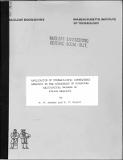Application of probabilistic consequence analysis to the assessment of potential radiological hazards of fusion reactors
Author(s)
Sawdye, Robert William; Kazimi, Mujid S.
Download04759949.pdf (4.660Mb)
Other Contributors
United States. Department of Energy
Massachusetts Institute of Technology. Department of Nuclear Engineering
Metadata
Show full item recordAbstract
A methodology has been developed to provide system reliability criteria based on an assessment of the potential radiological hazards associated with a fusion reactor design and on hazard constraints which prevent fusion reactors from being more hazardous than light water reactors. The probabilistic consequence analyses, to determine the results of radioactivity releases, employed the consequence model developed to assess the risks associated with light water reactors for the Reactor Safety Study. The calculational model was modified to handle the isotopes induced in the structural materials of two conceptual Tokamak reactor designs, UWMAK-I and UWMAK-III. Volatile oxidation of the first wall during a lithium fire appears to be a primary means of disrupting induced activity, and the molybdenum alloy, TZM (UWMAK-III), tends to be more susceptible than 316 stainless steel (UWMAK-I) to mobilization by this mechanism. It was determined that the radiological!
hazards associated with induced activity in these reactor designs imply reliability requirements comparable to those estimated for light water reactors. The consequences of estimated maximum possible releases of induced activity, however, are substantially less than the maximum light water reactor accident consequences.
Description
"July 1978." Originally presented as the first author's thesis, (M.S.)--in the M.I.T. Dept. of Nuclear Engineering, 1978 Includes bibliographical references (pages 87-89)
Date issued
1978Publisher
Cambridge. Mass. : Massachusetts Institute of Technology, Dept. of Nuclear Engineering, [1978]
Series/Report no.
MITNE ; no. 220